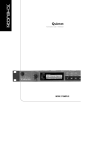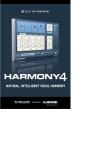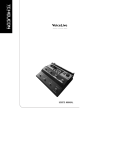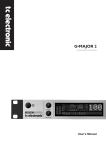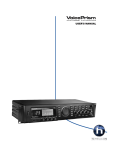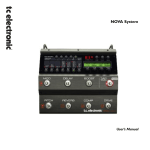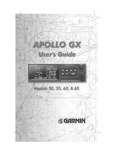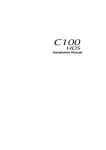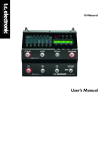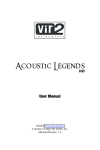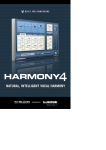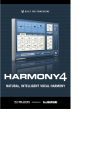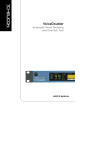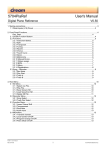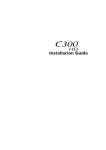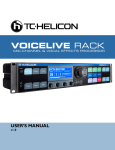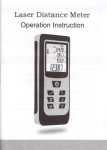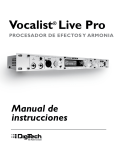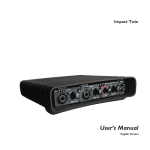Download Quintet US 101 - TC
Transcript
Quintet Vocal Harmony + Reverb USER’S MANUAL IMPORTANT SAFETY INSTRUCTIONS The lightning flash with an arrowhead symbol within an equilateral triangle, is intended to alert the user to the presence of uninsulated "dangerous voltage" within the product's enclosure that may be of sufficient magnitude to constitute a risk of electric shock to persons. The exclamation point within an equilateral triangle is intended to alert the user to the presence of important operating and maintenance (servicing) instructions in the literature accompanying the product. 1 2 3 4 5 6 7 Warning! • To reduce the risk of fire or electric shock, do not expose this apparatus to rain or moisture. • This apparatus must be earthed. • Use a three wire grounding type line cord like the one supplied with the product. • Be advised that different operating voltages require the use of different types of line cord and attachment plugs. • Check the voltage in your area and use the correct type. See table below: 8 9 10 11 12 13 Read these instructions. Keep these instructions. Heed all warnings. Follow all instructions. Do not use this apparatus near water. Clean only with dry cloth. Do not block any ventilation openings. Install in accordance with the manufacturer's instructions. Do not install near any heat sources such as radiators, heat registers, stoves, or other apparatus (including amplifiers) that produce heat. Do not defeat the safety purpose of the polarized or grounding-type plug. A polarized plug has two blades with one wider than the other. A grounding type plug has two blades and a third grounding prong. The wide blade or the third prong are provided for your safety. If the provided plug does not fit into your outlet, consult an electrician for replacement of the obsolete outlet. Protect the power cord from being walked on or pinched particularly at plugs, convenience receptacles, and the point where they exit from the apparatus. Only use attachments/accessories specified by the manufacturer. Unplug this apparatus during lightning storms or when unused for long periods of time. Refer all servicing to qualified service personnel. Servicing is required when the apparatus has been damaged in any way, such as power-supply cord or plug is damaged, liquid has been spilled or objects have fallen into the apparatus, the apparatus has been exposed to rain or moisture, does not operate normally, or has been dropped. Voltage Line plug according to standard 110-125V UL817 and CSA C22.2 no 42. 220-230V CEE 7 page VII, SR section 107-2-D1/IEC 83 page C4. 240V • • • BS 1363 of 1984. Specification for 13A fused plugs and switched and unswitched socket outlets. This equipment should be installed near the socket outlet and disconnection of the device should be easily accessible. Do not install in a confined space. Do not open the unit - risk of electric shock inside. Caution: You are cautioned that any change or modifications not expressly approved in this manual could void your authority to operate this equipment. Service • There are no user-serviceable parts inside. • All service must be performed by qualified personnel. a IMPORTANT SAFETY INSTRUCTIONS EMC / EMI. This equipment has been tested and found to comply with the limits for a Class B Digital device, pursuant to part 15 of the FCC rules. These limits are designed to provide reasonable protection against harmful interference in residential installations. This equipment generates, uses and can radiate radio frequency energy and, if not installed and used in accordance with the instructions, may cause harmful interference to radio communications. However, there is no guarantee that interference will not occur in a particular installation. If this equipment does cause harmful interference to radio or television reception, which can be determined by turning the equipment off and on, the user is encouraged to try to correct the interference by one or more of the following measures: • • • • Reorient or relocate the receiving antenna. Increase the separation between the equipment and receiver. Connect the equipment into an outlet on a circuit different from that to which the receiver is connected. Consult the dealer or an experienced radio/TV technician for help. For customers in Canada: This Class B digital apparatus complies with Canadian ICES-003. Cet appareil numérique de la classe B est conforme à la norme NMB-003 du Canada. b Certificate Of Conformity TC Electronic A/S, Sindalsvej 34, 8240 Risskov, Denmark, hereby declares on own responsibility that following products: Quintet - Vocal Harmony + Reverb - that is covered by this certificate and marked with CE-label conforms with following standards: EN 60065 Safety requirements for mains (IEC 60065) operated electronic and related apparatus for household and similar general use EN 55103-1 Product family standard for audio,video, audio-visual and entertainment lighting control apparatus for professional use. Part 1: Emission. EN 55103-2 Product family standard for audio, video, audio-visual and entertainment lighting control apparatus for professional use. Part 2: Immunity. With reference to regulations in following directives: 73/23/EEC, 89/336/EEC Issued in Risskov, March 2002 Mads Peter Lübeck Chief Executive Officer TABLE OF CONTENTS INTRODUCTION MIDI IMPLEMENTATION Table of Contents . . . . . . . . . . . . . . . .3 Text Conventions . . . . . . . . . . . . . . . .3 Introduction . . . . . . . . . . . . . . . . . . . . .5 Parameters Accessible via MIDI . . . .21 MIDI Implementation Chart . . . . . . . .21 SPECIFICATIONS BASIC OPERATION Front Panel . Rear Panel . Signal Flow . Applications . . . . . . . . . . . . . . . . . . . .6 . . . . . . . . . . . . . . . . . . . .8 . . . . . . . . . . . . . . . . . . . .9 . . . . . . . . . . . . . . . . . . .10 Preset Handling Parameter Types . . Preset Types . . . . . Global Reverb/Mix Recall . . . . . . . . . . Edit . . . . . . . . . . . . Store . . . . . . . . . . . . . . . . . . . . . . . . . . . . . . . . . . . . . . . . . . . . . . . . . . . . . . . . . . . . . . . . . . . . . . . . . . . . . . . . . . . . . . . . . .12 .12 .12 .12 .12 .12 . . . . . . . . . . . . . . . . . . . . . . . . . . . . . . . . . . . . . . . . .13 .14 .14 .14 .15 Technical Specifications . . . . . . . . . .23 TEXT CONVENTIONS Names of front panel controls and keys are written in CAPITALS. Parameter names are in SMALL CAPITALS. Parameter values are in underline. Special notes appear in italic. VOICE KEYS Voice Keys . . . . . . . . . . Levels Key . . . . . . . . . . EDIT/Hold for Setup Key Edit Menu Parameters . Setup Menu Parameters . . . . . FOOTSWITCH CONTROL Alternate Settings . . . . . . . . . . . . . . .16 HARMONY AND TUNING Harmony . . . . . . . . . . . Harmony Modes . . . . . Notes Mode . . . . . . . . Shift Mode . . . . . . . . . Chord (Chordal) Mode Scale (Scalic) Mode . . Diatonic and Chromatic Just Tuning . . . . . . . . . . . . . . . . . . . . . . . . . . . . . . . . . . . . . . . . . . . . . . . . . . . . . . . . . . . . . . . . . . . . . . . . . . . . . . . . . . . . . . . . . .17 .17 .17 .17 .17 .18 .19 .20 English Version Prod. No: E60502501 Rev 1.00 – SW – V 1.00 3 INTRODUCTION Thank you for purchasing the TC-Helicon Quintet Vocal Harmony and Effects processor. Quintet is the affordable key to great live and recorded vocals. Drawing upon the TC-Helicon heritage, the Quintet is fast and easy to use. It supports simple editing and control of harmony and effect parameters either from the front panel or via MIDI. Quintet is a state-ofthe-art product and creates the world's most natural sounding harmonies. The signal path includes a studio-quality mic pre-amp, superior manual and automatic pitch-shifting, as well as critically-acclaimed TC Electronic Reverb. We hope you will enjoy using the Quintet as much as we enjoyed designing it. Features: • HybridShift(TM) harmony generation for smooth, natural sound • Five distinct harmony Modes: Scalic, Chordal, Shift, Thicken and MIDI Notes • Humanization of harmony voices • Selectable Equal Temperament or Just Tuning for harmonies • High Quality Mic Preamp • MIDI CC control • MIDI CC 'echo' of front-panel controls • A/B program switching for live performance • 24-bit processing with 44.1/48 kHz S/PDIF output • Works with TC-Helicon Switch-3 footswitch accessory Please refer to this manual often, as there are many features and variations to explore. Our website is another good source for applications, support and other user services. Enjoy! The TC-Helicon Team www.tc-helicon.com 5 FRONT PANEL POWER KEY On/Off switch for the unit. In order for altered SETUP and current preset parameters to be saved, the unit must be powered off using this switch. Powering down by removing AC power will result in loss of changes to these parameters. LINE INPUT LEVEL KNOB Adjusts the Line Input level. Range: 24dB INPUT METER Peak meter shows Input level. The Meter range is: 0 to -40dB. INPUT CLIP LED Indicates that the input level is too high, possibly causing digital distortion. Reduce the input level to correct this condition. 6 OUTPUT CLIP LED Indicates an internal DSP overflow. Reduce the overall level of the harmony voices and vocal effects to correct this condition. MIDI IN LED Indicates valid incoming MIDI information. LCD TEXT DISPLAY Displays top-level preset information (preset recall mode), detailed preset information (edit menus), system configuration (setup menu), and any important status messages or user alerts. VOICE KEYS (1-6) On/Off function to set voicing. These keys allow you to select the voicing of the four harmony voices. A maximum of 4 of these keys may be enabled at a time. FRONT PANEL LEVELS KEY Press to adjust overall harmony, lead and reverb levels. Press repeatedly to cycle through the various level parameters. Not pressing this key for a few seconds causes the unit to revert back to the preset recall mode. EDIT/HOLD FOR SETUP KEY Press to enter the edit menu. Press repeatedly to cycle through preset edit parameters. All parameters in the edit menu are stored in the preset and include parameters related to harmony and reverb. Press and hold to enter the setup menu. Press repeatedly to cycle through the setup parameters. All parameters in the setup menu are global and are active regardless of the preset. voices are muted. RECALL KEY Press RECALL from any menu (edit or setup), or from the store mode to return to top-level preset recall mode. Press RECALL from recall mode to recall a preset (overwriting the current preset) when the current preset has been edited or when previewing a different preset. STORE Press STORE to enter store mode. Pressing store when in store mode will store the current preset to the displayed location. The STORE key LED blinks when the current preset has been edited. BYPASS Press to toggle (bypass / unbypass) all effects. MIC INPUT Press to select Mic input for processing (the line input becomes an AUX input when the MIC input is enabled) -20dB Press to enable a -20dB pad on the microphone input. MIC GAIN Adjusts Mic Input Gain. Range: 40dB. This in combination with the -20dB pad provides 60dB range of gain. DATA WHEEL Edits the value of the current parameter from any menu or mode. In recall mode, turning the wheel previews presets (top level preset information is flashed on the display but preset data is not loaded until RECALL is pressed again). HARMONY MUTE Pressing mutes the harmony voices. When lit the harmony 7 REAR PANEL Balanced Mic Input Balanced Jack Analog Input Balanced Jack Analog Outputs The 1/4” analog Input and Output connectors on the Quintet are balanced 1/4” jacks. Optimal connection to balanced equipment is achieved using balanced cables. However, if your equipment is NOT balanced you will generally have no problems using standard mono-to-mono cables as illustrated below. Mono 1/4” Cable TIP GND GND TIP 8 TRS (Tip Ring Sleave) 1/4” balanced Cable TIP RING GND GND RING TIP Digital S/PDIF Output MIDI In, Out, Thru MIDI Cable DIN CONNECTOR 5POLE - MALE 45 degrees External Control DIN CONNECTOR 5POLE - MALE 45 degrees max. 10m SHIELDED CABLE (3 or 5 wires + screen) Balanced XLR Cable - 3 Pin Type SIGNAL FLOW 9 APPLICATIONS Live Setups Using the Quintet live is like bringing four professional backup singers to your gig! You’ve got several options when it comes to controlling the Quintet Live. For best results you can use (in various combinations) the Switch-3 footswitch, a MIDI keyboard, a MIDI CC controller, and of course the controls on the front panel. We’ve provided setup examples below for a few common situations. Live Setup with a MIDI Keyboard • Connect a microphone to the XLR mic input on the Quintet and enable MIC input from the front panel. • Connect the keyboard MIDI Output to the Quintet MIDI input. • Plug the Switch-3 footswitch into the Quintet Pedal In jack. This allows foot control of BYPASS, HARMONY MUTE and selection of alternate presets. • Connect the Quintet stereo outputs to a stereo channel (or two mono channels) on your mixer. For mono operation use either of the Quintet outputs and set the unit to mono operation with the OUTPUT parameter under the setup menu. Live Setup with Guitar • Connect a microphone to the XLR mic input on the Quintet and enable MIC input from the front panel. • Plug the Switch-3 footswitch into the Quintet Pedal In jack. This allows foot control of BYPASS, HARMONY MUTE and selection of alternate presets. • Connect a guitar to your mixer and enable its effect send. • Take an effects send from your mixer and connect it to the Quintet Line input (it acts as the Aux input when the MIC input is enabled). Anything connected to the Line input in this mode can be mixed through the Quintet’s Reverb. • Connect the Quintet stereo output to a stereo channel (or two mono channels) on your mixer. For mono operation use either of the Quintet outputs and set the unit to mono operation with the OUTPUT parameter under the setup menu. 10 APPLICATIONS Computer Based Studio Setup The Quintet’s pristine -128dB EIN (Equivalent Input Noise) mic preamp and 24 bit A/D conversion alone justifies its place in your Studio rack. The ability to create high quality, solo-able harmony vocals makes the Quintet a must-have for anyone working with Vocals. We’ve put together an example below for a basic studio setup. Studio Setup • Connect a microphone to the XLR mic input on the Quintet. • Connect the S/PDIF out from Quintet to the S/PDIF in on your computer. • If you’re recording/sequencing software has the capability to echo incoming MIDI to MIDI out (most do), connect the MIDI out of your controller Keyboard to the MIDI in on your computer and configure it to pass the Keyboard’s MIDI messages through to the Quintet. • Connect the MIDI out from the computer to the MIDI in on the Quintet. • Connect the right and left outputs of the Quintet to your mixer and monitor in real time what the Quintet is doing without dealing with the time delay associated with routing the signal in and out of the computer. • Connect the computer stereo audio outputs to your mixer. 11 PRESET HANDLING Parameter types The Quintet has many useful parameters and a user interface that lets you easily view and edit them. Some parameters are preset based and some are setup based. Preset parameters are all the parameters found under the edit menu as well as the selection of voices by the VOICE KEYS. Each preset has its own set of these parameters. Setup parameters are global and do not change when a different preset is recalled. Setup parameters are the parameters found under the setup menu and are accessed by pressing and holding the EDIT/HOLD FOR SETUP key. Preset Types It’s important to understand the concept of the current preset versus stored presets. The current preset is the preset that is active in the Quintet. Recalling a preset copies preset data from one of the 50 stored presets into the current preset. As you change the current preset, the underlying stored preset is not affected until you choose to store the current preset back to a stored preset. When presets are recalled or previewed, the LCD displays the harmony mode, and the root/scale/chord information when applicable. Global Reverb/Mix If you select On for either the GLOBAL REVERB or GLOBAL MIX parameters in the setup menu, the effect/mix settings that were active when the parameters were set to On will be used regardless of the current preset effect settings. If you store the current preset while the GLOBAL REVERB or GLOBAL MIX parameters are set to On, all parameters except Reverb and mix settings will be stored to that preset. RECALL Recalling a preset means loading/activating a stored preset. The stored preset data is copied into the current preset. • Press RECALL to enter recall mode. • Use the DATA WHEEL to preview presets. 12 Blinking preset number/information indicates a previewed preset. Previewing means that you have not actually loaded the preset. • Press RECALL to recall/activate the currently previewed preset. This transfers the stored preset to the current preset. Press any other key at any time during previewing to return to the currently recalled preset. All 50 presets shipped with the Quintet can be modified and stored. Edit To edit preset parameters: • Click the EDIT/HOLD FOR SETUP key. • Tab through the menu of parameters by repeatedly pressing the EDIT/HOLD FOR SETUP key. A flashing cursor will appear over the data that you can edit using the DATA WHEEL. STORE To store a preset: • Press STORE. • You can store to the current location, or you can select a different location using the DATA WHEEL. • When you are ready, press STORE again to store the preset to the chosen location. Presets Backup Via MIDI The Quintet allows backing up presets via MIDI system exclusive, but requires a sysex dump request to do so. To learn how to request preset MIDI dumps, refer to the SYSEX MIDI documentation on our website. The Quintet is always ready to receive MIDI System Exclusive Dumps. Simply connect MIDI Out from the device you are dumping from to the MIDI In on the Quintet and send the Sysex dump at any time. VOICE KEYS VOICE KEYS These are the keys with the musical note icons. Pressing these keys results in the enabling/disabling of the individual harmony voices and selects the voicing. There is a maximum of four voices that may be activated at a time. The keys provide different results depending on the harmony mode of the preset. A quick guide legend is printed above the VOICE KEYS on the front of the Quintet. Scale Mode Presets In this mode the VOICE KEYS produce scalebased harmonies. It is important in Scale mode harmonies that the correct key and scale type of the song for which the preset is being used is selected in the edit mode. For a full description of Scale mode harmonies please refer to the “Harmony and Tuning” section of the manual. BASS Enables a harmony voice one octave below the input voice. LOWER Enables a harmony voice a sixth below the input voice. LOW Enables a harmony voice a fourth below the input voice. UNISON Enables a voice that is in unison with the input voice. ABOVE Enables a harmony voice a third above the input voice. TOP Enables a harmony voice a fifth above the input voice. Chord Mode Presets In this mode the VOICE KEYS produce chordbased harmonies. In chord mode presets, the harmony voices are always notes in the chord. For example, the ABOVE key produces a harmony voice the next note above the note of the input voice in the chord. If the Chord was C Major and the input note was an E, the ABOVE key would produce a G harmony voice, just above the input E. The voicing options for chordal mode presets are shown below. BASS Enables a harmony voice that is the root of the chord. LOWER Enables a harmony voice in the chord two notes below the input note. LOW Enables a harmony voice in the chord one note below the input note. UNISON Enables a harmony voice in the chord closest to the input note. ABOVE Enables a harmony voice in the chord one note above the input note. TOP Enables a harmony voice in the chord two notes above the input note. Shift Mode Presets In this mode the voices are shifted a fixed amount relative to the input note. The voicing options for Shift mode presets are shown below. BASS Enables a harmony voice that is two octaves below the input note. LOWER Enables a harmony voice that is one octave below the input note. LOW Enables a harmony voice that is a fourth below the input note. 13 VOICE KEYS - LEVELS KEY- EDIT/Hold for Setup KEY UNISON Enables a voice that is in unison with the input note. ABOVE Enables a harmony voice that is a fifth above the input note. TOP Enables a harmony voice that is an octave above the input note. Thicken Mode Presets In this mode, the voices are all unison with the input voice but slightly detuned and time randomized. The VOICE KEYS allow selection of genders or timbres ranging from deep with the BASS voice key for a more mature sounding voice to thin with the HIGHER voice key for a younger sounding voice. Notes Mode Presets In this mode the pitch of the voices are controlled by MIDI input. In this way you are able to play the harmony voices with a keyboard or a MIDI sequencer. The VOICE KEYS allow selection of genders or timbres ranging from deep with the BASS voice key for a more mature sounding voice to thin with the HIGHER voice key for a younger sounding voice. Selecting the BASS voice key would result in a single voice of harmony, with a deep timbre that is controlled by MIDI note input. LEVELS KEY This key gives the user control over audio levels of the LEAD, HARMONY and REVERB audio components. Repeatedly pressing the LEVELS key will cycle through the LEAD, HARMONY and REVERB level parameters. The display will revert back to recall mode after 3 seconds of inactivity. EDIT/Hold for Setup KEY Edit Menu Parameters Pressing the EDIT/HOLD FOR SETUP key gives access to the edit menu parameters. Repeatedly pressing this key will cycle through the following parameters: 14 HARMONY MODE Select the harmony mode. Available parameters: Scale (Scalic presets), Chord (Chordal presets), Shift, Thicken and Notes (Shift, Thicken and Notes presets). See the “Harmony, and Tuning” section of the manual for a full description of each harmony mode. ROOT Sets the scale root in Scale Mode presets; sets the chord root in Chord Mode presets. SCALE/CHORD Sets the scale type In Scale Mode presets; sets the chord type in Chord mode presets. (The Chord name in the display will change if incoming MIDI notes are detected as representing valid chords). SMOOTH Sets how much of the input pitch nuance is applied to the output voice. Not applicable to Shift presets. In Scale Mode presets the unison voice is effectively pitch corrected to the chosen scale. Setting the Smoothing parameter to 0% results in hard pitch correction while setting to 100% results in no pitch correction. TUNING This gives the option of either Equal temperament, Just intonation, or Barbershop tuning modes. See the “Harmony, and Tuning” section of the manual for a full description of each tuning mode. LATCH When enabled in chord mode presets, the last chord played remains active after the notes have been released from the MIDI keyboard. When enabled in Notes mode, the harmony voices will only respond to MIDI note input when the number of notes being played equals the harmony voices enabled. This ensures logical voice assignment when voices change. REVERB TYPE The list of reverb types includes the following acoustic simulations: Living Room, Chamber, Club, Classic Hall, Concert Hall, Large Cathedral, Vocal Studio, Vocal Room, Vocal Hall, Ambience, Live Reverb, Plate1, Plate2, and Spring. EDIT/Hold for Setup KEY Setup Menu Parameters Pressing and holding the EDIT/HOLD FOR SETUP key gives access to the setup menu parameters. Once the setup menu is entered, repeatedly pressing this key will cycle through the following parameters: MIDI CHANNEL Sets the base MIDI Send and Receive channel. MIDI FILTER With this parameter you can cause the Quintet to ignore certain MIDI commands and data. P ignore program changes. SX ignore system exclusive messages. DRY LEAD On, Off. Setting this parameter to Off removes the dry lead signal from the Quintet output. This allows using the Quintet as an effect on an effects bus where you want a completely wet output. When using the mic input or as an insert effect, set this parameter to On. OUTLEV This is like a multi-turn output level pot for the analog outputs. Range -80dBu to +20dBu. Please note that some mixers will produce a distorted signal with a +20dB signal. If you experience distortion and neither the input nor output clip lights are flashing on the Quintet, try adjusting this parameter to a lower setting. P+SX ignore program changes and system exclusive messages. OUTPUT Output Mode: Stereo or Mono. SYSEX ID This parameter sets the MIDI sysex ID for the Quintet. SAMPLE RATE: 44.1kHz, 48kHz. This parameter sets the digital audio sample rate. ZONE This parameter defines the note range of a MIDI keyboard that the Quintet will recognize when creating harmonies. For Example: Above C4- would specify that the Quintet would respond only to MIDI notes above C4 on the Keyboard. NOTES TRANS Notes Mode Transpose. This transposes the harmony voices in notes mode. The value corresponds to octaves. This is useful when used in conjunction with Keyboard Zone. REVERB Global, Preset. This parameter allows you to select whether the reverb type is different per preset or global for all presets. MIX Global, Preset. This parameter allows you to select whether the mix levels is different per preset or global for all presets. 15 FOOTSWITCH CONTROL The Quintet has been designed to work with the Switch-3, three button footswitch. **The Quintet must be powered up with the foot switch plugged in for proper operation.** The footswitch buttons provide the following control: BUTTON 1 This allows selection of the Main and Alternate settings for use with Scale Presets. BUTTON 2 Pressing this button is the same as pressing the BYPASS key on the front panel. BUTTON 3 Pressing this button is the same as pressing the HARMONY MUTE key on the front panel. Alternate Settings Alternate settings may be accessed only with a footswitch and are applicable to Scale Presets only. Alternate settings allow you to store different voicings, Scale Type and Scale root. To set alternate settings for a Scale Preset do the following: 1. Power up the Quintet with a Switch-3 footswitch plugged in. 2. Select a Scale Preset. 3. Press BUTTON 1 of the Switch-3 footswitch. Notice that there is now an “a” following the preset number. 4. You can now change which voices are enabled from the front panel for the Alternate setting. 5. Press the EDIT key to change the scale root and scale type. When alternate is selected you may change all parameters under the edit menu except for the HARMONY MODE parameter, however only the scale root and type will remain unique to the alternate settings, all other changes will affect the whole preset. 16 6. Store the preset by pressing the STORE button twice. See the Preset Handling section for details on storing presets. HARMONY AND TUNING Harmony Here's where we can go into a little more depth about harmonies. We've tried to keep it practical, focusing on what Quintet can do for you. Harmony Modes Quintet has five different harmony modes, which give five unique methods of creating harmony. Once we get into describing the more complex harmony modes, we’ll be showing you examples based on the C major scale. If you are unfamiliar with this scale we’ve shown C major here. Notes Mode In this Mode, you provide the Quintet with specific MIDI note information to determine the pitch of the harmony voices. Quintet has two “Manual/Notes” harmony modes, single and 4 channel. The Quintet may be set to Notes 4 Channel mode through MIDI CC#74 (see the MIDI implementation section of the manual). Notes 4 Channel mode allows you to send 4 channels of MIDI information, one for each individual harmony voice. This is the most direct and flexible way of creating harmonies, allowing you to weave complex melodies and counter harmonies irrespective of your lead vocal. Shift Mode Also known as “Fixed Interval”, this takes the pitch of your lead voice and creates harmonies a set number of semitones away, based on that pitch. The method of creating harmonies, using a fixed number of semitones relative to an input note or pitch, is called chromatic harmony, the theory of which we'll go into later. We consider this type of harmonizing to be non-intelligent because Quintet is not set to any particular key or scale. These are pure, parallel harmonies. The VOICE keys in the Quintet are set to the most common shift harmony voices which are the 5th (7 semitones) and octave (12 semitones), ranging from two octaves below the input to one octave above the input pitch. Chord (Chordal) Mode Chordal harmonies take your chord information to create intelligent, diatonic harmonies based on your voice. To make “Chordal” harmonies, you need to input in real time the chords of the song. This must be done via MIDI. Chord information consists of the chord root and type, which define the 3 or 4 notes in a given chord. In Chordal mode the Quintet will only create harmony voices that fall on the notes of the chord. Chordal harmonies are “intelligent” because they decipher the chord you’re playing and the note you’re singing to produce musically pleasing harmonies. When the ABOVE voice key is enabled on the Quintet, the next note from the chord above the input note is output for that harmony voice. The subsequent illustration shows the harmony notes for the C major scale with just the ABOVE voice key selected. Root: C, Chord Type: Maj, ABOVE voice key Black = Lead; Grey = Harmony You might have noticed that each harmony note can cover more than one input note, or that each input note doesn’t necessarily have a unique harmony note. For instance, C and D both have E as the 3rd above, E and F share G, and so on. This gives a more stepped sound to the harmony as the changes are both greater in magnitude and less frequent than when using other harmony methods (shift mode for example). The benefit of this method is that it is very easy to integrate vocal harmonies into your songs if you already know their chord progressions! The following lists the chords available with respect to the root of “C”: Maj Maj6 Maj7 Maj7sus4 Min Min6 Min7 Min7b5 Dim C C C C C C C C C E E E F Eb Eb Eb Eb Eb G G G G G G G Gb Gb A B B A Bb Bb 17 HARMONY AND TUNING Dim7 C Dom7 Dom7b5 Aug Aug7 Sus Sus2 Sus7 C C C C C C C Eb E E E E F D F Gb (equiv. G Gb G# G# G G G Bbb to A) Bb Bb Bb Bb Scale (Scalic) mode Harmonies use key and scale information to create musically correct, diatonic harmonies. Most popular songs use a single scale, so you usually only have to set the Quintet to that same scale at the beginning of your song. “Scalic” harmonies are more dynamic than the chordal harmonies because there are unique harmony notes for each input note. The illustration below shows the harmony notes for the C major scale with a voicing selection of a C major scale and a single “third above” harmony voice. You can see from the diagram that the “Scalic” harmonies are intelligent and closely follow your lead voice for a tighter sound. Black = Lead; Grey = Harmony Under the HARMONY key is a parameter called SMOOTHING . When set to 100% the harmony voices follow your input pitch, errors and all, but when set to 0% the harmonies will jump directly to the scalic harmony notes, like a hard pitch correction on the harmony voice. Setting the SMOOTHING parameter between 0 and 100% is like having variable amounts of pitch correction on the harmonies. It is also tricky to pick out the key in some songs. An example is “Sweet Home Alabama”. Listening, you might think this song is in the key of “D”, as that’s the first chord, but the harmonies actually work best in the key of “G” -try running the song through Quintet to hear for yourself. 18 The Quintet has five preprogrammed harmony scales: three major, three minor and one custom per preset. Setting the scale can also take a bit of practice: for songs centered around the third or root of the scale it might not sound like there’s any noticeable differences between the three major or three minor scales. This is because your song doesn’t hit any of the scale’s altered notes. A melody centered around the fifth of the scale, (such as B in the key of E), highlights the differences between the scales. Try the “Sha Lala Lala ...La Tee Daa” chorus of Van Morrison’s “Brown Eyed Girl” (key: E, scale: major, 3rd above voicing) with each major scale to hear the audible difference between them. For the minor scales, Santana’s “Evil Ways” (key: G, scale: minor, 3rd above voicing) highlights the differences between the three minor scales. The following table illustrates the third and fifth above for a given input note to illustrate the differences between the six different scales. “nc” means no change, in that the harmony voice will simply keep its previous pitch until the lead voice pitch changes to a non “nc” note. For complete voicing information see our website at www.tc-helicon.com Thicken Mode Thicken mode presets do not produce harmony voices, instead they produce voices in unison with the input voice. The unison voices have pitch and time humanization applied to them to make them sound as if sung by another person. HARMONY AND TUNING nc nc D F nc nc C Eb nc nc Ab C B D nc nc D F nc nc C Eb nc nc A C Bb D nc nc D F nc nc C Eb nc nc Ab C Bb D D F D F C E nc nc nc nc nc nc G Bb nc nc Shifting, which uses the chromatic, 12 semitone scale, changes the input pitch by a fixed number of semitones: Chordal, which uses the root, third, fifth and sometimes seventh of the many diatonic scales, pitches the harmony voice to the closest note contained within the chord: Scalic, which uses one of many diatonic scales, pitches the harmony voice to the nearest note contained within the scale: MIN3 3rd above 5th above Eb G F A nc nc G Bb nc nc MIN2 3rd above 5th above Eb G F A nc nc G Bb F Bb nc nc Eb G MIN1 3rd above 5th above nc nc MAJ3 3rd above 5th above E G F A nc nc G Bb A C Bb D D F D F C F nc nc nc nc nc nc MAJ2 3rd above 5th above E G F A nc nc G C A C C E B Bb D F C E A G# nc nc nc nc B D F# A C G B nc nc Eb D F A nc nc C# We've described scalic and chordal harmonies as diatonic, and shift harmonies as chromatic; but what do those words mean? Look at a piano keyboard. Between middle "C" and the next "C" there are twelve keys - 7 white keys and 5 black keys. Each of those keys are pitched one semitone apart for a total of, you guessed it, 12 semitones. The chromatic scale uses all twelve semitone notes opposed to the diatonic scales. Thus there is only one chromatic scale, but 12 each of the major, minor, etc. diatonic scales (C major, C# major, D major, etc). Most of us have grown up hearing the traditional "doh ray me fah so la tee doh" diatonic scale, so that harmonies based on the diatonic scale sound correct. What does this mean, harmony-wise? Diatonic scale harmonies can only use notes within specified scale or chord, so a “third above” harmony voice actually varies between 3 and four semitones above the lead note where the chromatic harmony would stay exactly 4 semitones (a major 3rd) above each note. To recap: we have three different harmony modes that use chromatic or diatonic scales. E G Lead Voice C 3rd Above 5th Above MAJ1 E F G D F Diatonic and Chromatic 19 HARMONY AND TUNING Theory aside, the best way to get great sound is to experiment with all of Quintet' possible harmony modes. Not only will you develop an intuitive sonic sense of what works best where, but by investigating different permutations and combinations you could discover some delightful sounds you might otherwise have missed. Just Tuning Why just tuning? Although probably no one has ever told you this, your expensive grand piano and the last great keyboard synthesizer you bought are both out of tune! Well, to be fair we can say instead that they are all tuned using Equal temperament. Harmony is the result of the interaction between differing audible frequencies in ratios that sound musical to the human ear. A more exact ratio leads to a nicer sounding harmony. Most instruments (like the piano) are absolute by nature. Each note on the keyboard has a specific pitch. Equal temperament tuning uses approximations for the tuning of each note, allowing us to easily alter the key of our music without re-tuning our instruments. Unfortunately, with this method of tuning we lose the ability to create perfect ratios when playing multiple notes. As a result, much of the harmony you’ve heard in music has not been perfectly in tune! The bottom line is that the approximations of equal temperament tuning are practical, but imperfect. Using the Quintet with Just tuning will definitely expand your musical horizons! Just tuning is the practice of maintaining the relative (and perfect) ratios between pitches, creating perfect harmonies. Singers, especially when performing multi-part a-cappella music, base their tuning on how it harmonically sounds with other singers. The natural tendency, and what sounds best, is to sing with “just tuning” so that beating is minimized. One of the goals in barbershop quartet singing is to strive for “just relative intonation” so that a sub-frequency is audible. Achieving this goal results in what barbershop fans often describe as the coveted "ring and lock" sound. In barbershop music it is the lead singer's 20 responsibility to try to sing the melody as close to the tuning of a piano (equal temperament) as possible. The other singers must then tune their harmonies to the melody, using “just relative intonation”. The Quintet is able to do this in both the Just and Barbershop tuning modes. When the Just or Barbershop Modes are selected in the Quintet, the harmony tunings are based on the following relationships: Minor 3rd = 3 cycles for every 4 cycles of the input Major 3rd = 5 cycles for every 4 cycles of the input 5th = 3 cycles for every 2 cycles of the input. Barbershop differs from Just tuning in Chordal mode. Just tuning will use the root of the chord for the tuning reference, while Barbershop tuning uses the input notes as the tuning reference. For this reason it is better to use Barbershop in an a-cappella situation and Just when playing with other instruments, because Just tuning sounds more in-tune with the other instruments that most likely have equal temperament tuning. Our best advice is to experiment and use your ears! MIDI IMPLEMENTATION Parameters Accessible via MIDI We’ve made the Quintet as simple as possible to use from the front panel - providing you with the parameters that are necessary to get 95% of what you need as quickly as possible. If you need to dive in a little further, we’ve made additional parameters available through MIDI. In order to be able to use these parameters effectively, a few concepts must be understood. The Quintet has 4 voices of Harmonies. The voices that are enabled via the VOICE KEYS are numbered 1 to 4 based on the Lit keys from left to right. If only two voices are enabled, that means that voices 1 and 2 would be active, voice 1 being the furthest to the left and voice 2 being furthest to the right. Now that you know which voice is which you can use MIDI to fine tune gender, vibrato, or panning of the voices. In the table below, detailed descriptions are given only for parameters that are not accessible via the front panel. Descriptions and values for front panel accessible parameter definitions can be found in earlier parts of the manual. To see how they map to CC values, go to the parameter in question on your Quintet and monitor the MIDI output while adjusting the parameter value. Parameter Name CC# Range / Description Voice 1 Level Voice 1 Gender 11 72 Voice 1 Vibrato Style 89 Voice 1 Vibrato Amount Voice 1 Pan 90 80 0-100 0-127 64 = Centre; <64 Left; <64 Right Voice Voice Voice Voice Voice 2 2 2 2 2 Level Gender Vibrato Style Vibrato Amount Pan 17 19 92 93 81 0-127 0-127 0-11 0-100 0-127 Voice Voice Voice Voice Voice 3 3 3 3 3 Level Gender Vibrato Style Vibrato Amount Pan 21 23 94 15 82 0-127 0-127 0-11 0-100 0-127 0-127 Adjusts individual voice level 0-127 64= neutral gender; <64 Male; >64 Female 0-11 0 = Ballad 1 = Tremolo 2 = Random Vibrato 3 = Broadway 4 = Excited 5 = Folk 6 = Fast 7 = Warm 8 = Discrete 9 = Head 10 = Random Tremolo 11 = Soprano 21 MIDI IMPLEMENTATION Parameter Name Voice 4 Level Voice 4 Gender Voice 4 Vibrato Style Voice 4 Vibrato Amount Voice 4 Pan CC# 25 27 3 105 83 Harmony Mode Root Harmony Level Smooth Humanization Style 29 30 12 36 40 Humanization Style Amount Tuning Mode Harmony Notes Attack Harmony Notes Release Harmony Latch Harmony Bypass 41 42 44 45 95 110 Reverb Level Reverb Type Lead Level Lead Pan Notes 4 channel Mix Global Setup Output Level Reverb Global Bypass All Global Vibrato Control 91 59 13 73 74 86 87 88 114 1 Range / Description 0-127 0-127 0-11 0-100 0-127 0-3 0-11 0-127 0-127 0 = Scoop Down 1 = Scoop Up 2 = Scoop and Time Randomization 3 = Scoop, Time and Pitch Randomization 4 = Time Randomization 5 = Time and Pitch Randomization 6 = Pitch Randomization 7 = Detune 0-127 0-2 0-127 0-127 0-63 Off, 64-127 On 0-63 Off, 64-127 On 0-127 0-13 0-127 0-127 0-63 Off; 64-127 On 0-127 0-127 0-63 OFF; 64-127 ON 0-63 Bypassed ,64-127 Enabled 0-127 Note: Wherever applicable, the entire CC range is mapped to a given parameter. Other Midi Messages: Program Change: Received/Transmitted. Pitch Bend: Received. Controls Pitch +/- 2 semitones fixed range Note On/Off: Received. Used in Chord and Notes presets. 22 TECHNICAL SPECIFICATIONS Digital Output Connector: Formats: Sample Rates: Processing Delay: Frequency Response DIO: RCA Phono (S/PDIF) S/PDIF (24 bit), 44.1 kHz, 48 kHz 0.1 ms DC to 22/23.9 kHz ± 0.01 dB @ 44.1/48 kHz Analog Inputs Connectors, balanced: Impedance: Balanced/Unbalanced Line Input Level @ 0 dBFS: Line Sensitivity @ 12 dB headroom: Mic. Input Level @ 0 dBFS: Pad Off/On Mic. Sensitivity @ 12 dB headroom: Pad Off/On Line, Mic. @ Min gain, Dynamic Range: NF/Vi @ Max. micamp. gain, Rg = 200 Ohm: THD: Line Frequency Response: Mic. Frequency Response, max gain: Crosstalk: A to D Conversion: A to D Delay: Mic.: XLR, Line: ¼"phone jack Mic.: 3.6/1.8 kOhm, Line: 21/13 kOhm 24 dBu to 0 dBu -12 dBu to 12 dBu -13 dBu/7 dBu to -53 dBu/-33 dBu -25 dBu/-5 dBu to -65 dBu/-45 dBu > 92 dB, 20 Hz - 20 kHz < 2 dB / -127.4 dBu < -100 dB (0,001 %) @ 1 kHz +0/-0.1 dB, 20 Hz to 20 kHz -1.5 dB @ 40 Hz, +0/-0.1 dB (200 Hz to 20 kHz) <-85 dB, 20 Hz to 20 kHz 24 bit, 128 x oversampling bitstream 0.65/0.70 ms @ S.R. = 48/44.1 kHz Analog Outputs D to A Conversion: D to A Delay: Connectors, balanced: Output Impedance: Max. Output Level: Output Range: Dynamic Range: THD: Frequency Response: Crosstalk: 24 bit, 128 x oversampling bitstream 0.63/0.68 ms @ S.R.= 48/44.1 kHz ¼"phone jack 40 Ohm 20 dBu/14 dBu, R-load = 1200 Ohm Variable up to +20dBu > 104 dB, 20 Hz to 20 kHz <-98 dB (0.0013 %) @ 1 kHz +0/-0.3 dB, 20 Hz to 20 kHz <-100 dB, 20 Hz to 20 kHz EMC Complies with: Safety Certified to: Balanced/Unbalanced EN 55103-1 and EN 55103-2 FCC part 15, Class B, CISPR 22, Class B IEC 65, EN 60065, UL6500 and CSA E60065 CSA FILE #LR108093 Environment Operating Temperature: Storage Temperature: Humidity: 32° F to 122° F (0° C to 50° C) -22° F to 167° F (-30° C to 70° C) Max. 90 % non-condensing Control Interface MIDI: Pedal: In/Out/Thru: 5 Pin DIN 1/4" phone jack Supplementary Display: Dimensions: Weight: Mains Voltage: Power Consumption: Warranty Parts and labor: 16 x 1 character LCD display 19" x 1.75" x 8.2" (483 x 44 x 195 mm) 4.1 lb. (1.85 kg) 100 to 240 VAC, 50 to 60 Hz (auto-select) <15 W 1 year Due to continuous development these specifications are subject to change without notice. 23

























